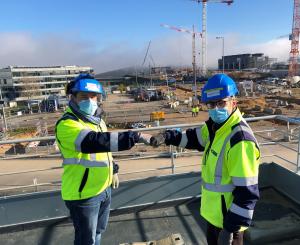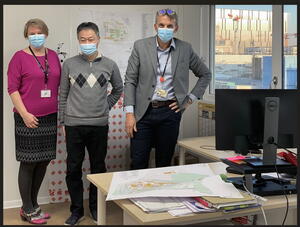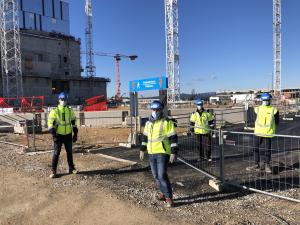ITER teams now fully in charge of platform coordination
The oil has been changed but the engine keeps humming along.
Anyone walking along the new pedestrian pathway running between the cooling tower zone and the Tritium Building on the ITER platform wouldn't have noticed anything special. There was the same fresh asphalt, the same blue indicator signs, and the same metal protection barriers. Just another unremarkable piece of minor roadwork at ITER.
However, this project was evidence that another important ITER milestone has been reached. The overall coordination of the common areas of the ITER platform—everything from signage and emergency assembly points to parking spaces and smoking areas—had been the exclusive responsibility of the European Domestic Agency (Fusion for Energy) since the project first broke ground in 2007. Now, because key work targets have been met, ITER's Construction Management Office (CMO) is assuming responsibility for these common areas, including road works such as the new pedestrian path that opened at the end of October 2021.
"This transfer of platform coordination responsibility is a significant moment for ITER," says Yves Belpomo, the Deputy Head of the Construction Management Office and Section Leader for Site Planning & Coordination (SPC). "We can consider it successful if people haven't realized it happened. It's like the oil has been changed in the engine: everything is still running smoothly, so it means we're doing our job."
The role of the Construction Management Office at ITER is to provide transversal support and coordinate logistics for the site's construction activities. In 2020, the Office was reorganized and expanded to deal with the increased amount of assembly activity. The new team is led by Katsumi Okayama and it has more than three dozen staff devoted to overseeing activities such as logistics, warehousing, lifting, and scaffolding as well as overall facility management, office planning, and general on-site services such as the cafeteria.
"We have a very broad mandate," says Katsumi. "We don't do the cooking, but we joke that if people are not happy with the menu, then our Office will be blamed!"
The new site coordination responsibilities are an example of the Office's expanded scope. The ITER Organization had agreed with Fusion for Energy that the operational and financial responsibility for site coordination would be initiated when 75 percent of its site works contract TB16 (service trenches, precipitation drainage, and site adaptation works such as roads and lighting) was completed. This threshold was passed in September 2021; as a result, the official transfer of power began on 1 October 2021 and is expected to be completed by the end of February 2022.
The transfer has been illustrative of the transversal coordination puzzles the Construction Management Office routinely needs to solve. Up until now, the logistics works in the common areas on the ITER site were under Fusion for Energy control and the day-to-day management was overseen by its Architect Engineer ENGAGE. Now, the ITER Organization is managing site coordination through its Construction Management-as-Agent MOMENTUM. This meant that hundreds of logistics work files, some in the planning stages, some in progress, had to be transferred or monitored, requiring intense cooperation between the old Fusion for Energy team from ENGAGE and the new ITER team from MOMENTUM. Specifically, the two platform coordinators—ENGAGE's Didier Labarthe and MOMENTUM's Gregory Thibault—have had to get to know each other extremely well. "We talk 10 or 15 times a day and we go to a lot of meetings," explains Gregory. "But it's all been necessary and it's a friendly process because we are taking a best-for-project approach to make sure the day-to-day operations continue smoothly."
The pedestrian pathway in question and the adjoining roadway is a 10-metre x 60-metre stretch of pavement that runs east of the Tritium Building. The job involved scraping away the temporary path and road structure and then adding a 30-centimetre layer of backfill and a 20-centimetre layer of asphalt that will last for the lifetime of the ITER project. The work was done by the construction firm Valérian under the TB16 contract and with management from ENGAGE. However, because construction began after the platform coordination transfer was initiated, MOMENTUM and ENGAGE are jointly ensuring the interfaces with other contractor works and shared temporary infrastructure on the ITER platform. The pedestrian pathway opened at the end of October 2021, while the new roadway will be officially opened at the end of January 2022.
"It may seem like an ordinary stretch of road, but for us, it is a strong symbol of our cooperation and the transfer as a whole," says Guillaume Merriaux Mansart, the head of transversal activities for MOMENTUM. "These types of projects may be low profile, but our team knows they play a big role at ITER."




